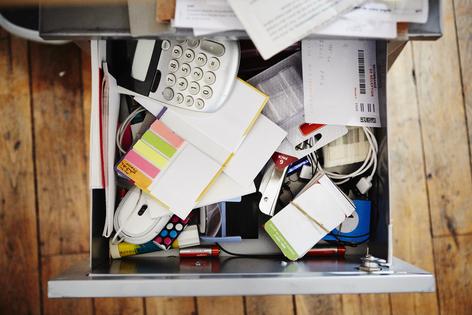Do you struggle with ‘clutter creep’?
A few months ago, you proudly nixed a ton of excess clutter in your home and happily basked in the joy of tidy surfaces. But today, as your eyes shift around your space, you realize you’re somehow surrounded by a muddled mess again. What gives? You’ve probably got a case of clutter creep, an ubiquitous conundrum that affects even those with the best intentions.
Why clutter creep happens — even in organized homes
Clutter creep is a slow accumulation of clutter over time that sort of sneaks up on you. One day, your home is tidy, and the next, you’ve got rogue piles and littered surfaces working against your #organizationgoals.
“It’s a slow, almost invisible buildup of stuff that happens when we’re not paying attention,” says Anita Yokota, a licensed therapist and interior designer.
How clutter creep affects your brain (and mood)
Yokota adds that, along with making it harder to find items, science has found a correlation between clutter and our mental well-being.
“There’s research showing that clutter can actually raise cortisol levels, especially in women. In other words, it has a physiological effect,” she says.
So, essentially, clutter = stress!
Decluttering tips that actually work to prevent clutter creep
These expert tips curb clutter creep at a fundamental level to prevent those piles from sneaking up on you time and again.
Identify and document clutter zones. Start by writing down all the piles you see in your home. This may feel overwhelming, but identifying clutter zones puts you in control.
“Write down every pile you want to tackle,” says Jessica Litman, professional organizer and founder of The Organized Mama. “Once you see the list, you can take action.”
Tackle clutter in short bursts. You don’t have to address every single clutter zone on your list in a day. Instead, work in short bursts. Maybe you give yourself the length of your favorite podcast, a chapter of your book, or simply set a timer for 20 minutes.
Create a “holding box” to minimize decision-fatigue.“Instead of deciding on the spot whether to keep or toss something, place it in a ‘holding box’ and let it sit for 24 to 48 hours,” Yokota says. “This gives you a chance to ask: Do I really use this? Does this still serve me? That short pause can help break the cycle of impulsive decision-making.”
After a day or two, sort through the holding box. You might be surprised at how easily the decisions come.
Adopt the daily micro-decluttering technique.“Spend five minutes every day removing clutter quickly, like those things you know can go in the recycling or garbage,” Litman says.
Make sure every item has a “home.” Take the time to give everything in your home a designated spot. “You don’t have to find all the items and put them there, but give everything a spot with a label,” Litman says. “Then, as you find things, add them to that spot.”
Reset your body’s craving loop. When the urge to buy something new hits, don’t give in to the desire so quickly. Instead, take a pause. “You’re likely chasing a dopamine hit and not something you truly need,” Yokota explains. “Step outside. Drink water. Organize a drawer. Redirecting that impulse can train your brain to find satisfaction in presence, not purchase.”
(Real Simple magazine provides smart, realistic solutions to everyday challenges. Online at www.realsimple.com.)
©2025 Dotdash Meredith. All rights reserved. Used with permission. Distributed by Tribune Content Agency, LLC.





























Comments